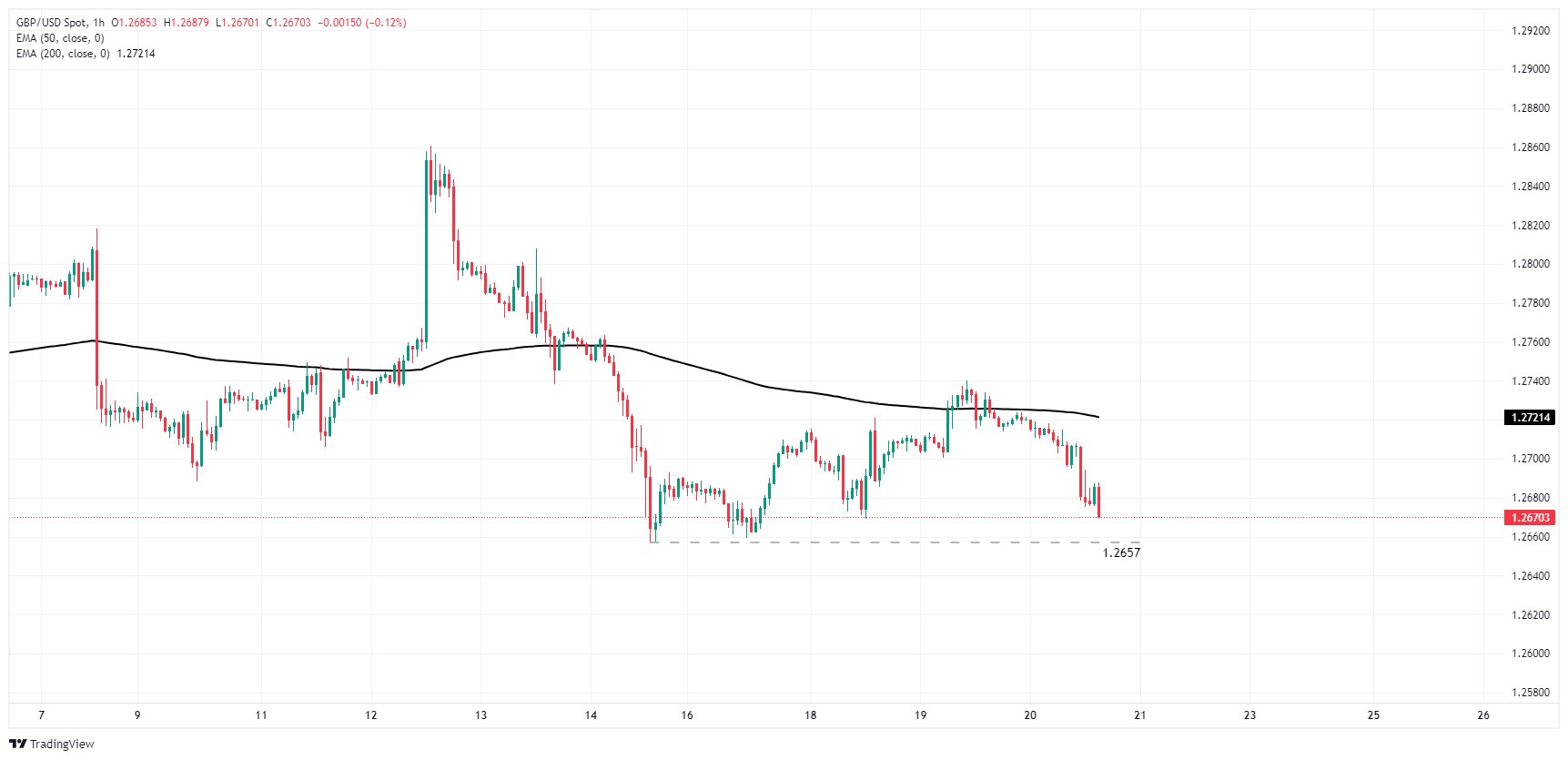GBP/USD backslides after BoE holds rates citing concerns over sustainable inflation

- GBP/USD back below 1.2675 after BoE keeps rates pinned.
- BoE voting split remains unchanged at seven-to-two.
- Softer US data further eroded market sentiment, bolstering Greenback.
GBP/USD slipped lower on Thursday after the Bank of England (BoE) held rates at 5.25%, citing ongoing concerns about the central bank’s ability to sustainably keep inflation at or below the 2.0% target. US data was broadly softer than investors had expected in early American trading, igniting a soft patch of risk aversion which kept the US Dollar bid and Sterling pinned into the low end.
Read more: BoE maintains policy rate at 5.25% as forecast
The BoE was broadly expected to keep rates held in place in June, but a focus on recent services inflation coupled with an ambiguous goal to keep inflation “sustainably” lower has left the Sterling in the lurch. Adding onto this, the BoE also noted a willingness to keep policy restrictive for as long as needed, and highlighted that the UK labor market, while looser than previous, still remains historically tight. The Sterling is down around a third of a percent against the extending US Dollar as Thursday’s market action rolls on.
US Initial Jobless Claims missed the mark, coming in higher than expected for the week ended June 14. Week-on-week unemployment claimants are still lower, printing at 238K versus the previous 243K (revised from 242K), but still came in above the four-week trending average of 242.75K, which itself also rose from the previous 227.25K.
The Philadelphia Fed Manufacturing Survey for June backslid to 1.3 from the previous 4.5, entirely missing the forecast 5.0. US Housing Starts also softened, falling back to 1.277 million new residential construction projects MoM in May versus the forecast 1.37 million and the previous month’s 1.352 million (revised from 1.36 million).
Friday will round out the Cable’s trading week with a bang, with UK Retail Sales and a fresh update to S&P Global Purchasing Managers Index (PMI) figures for both the UK and the US. UK retail sales are expected to rebound to 1.5% MoM in May compared to the previous -2.3% decline, while UK PMIs are expected to tick slightly higher. The Manufacturing PMI is forecast to increase to 51.3 from 51.2, and the Services component is expected to bump to 53.0 from 52.9.
On the US side, Manufacturing and Services PMIs are both forecast to tick lower, with Manufacturing expected to slip to 51.0 from 51.3 and Services sliding to 53.7 from 54.8.
GBP/USD technical outlook
The Pound Sterling fell back below the 1.2700 handle against the US Dollar on Thursday, shedding weight and turning lower in a race back to near-term lows at 1.2657. Technicals favor a bearish extension as price action flubs the 200-hour Exponential Moving Average (EMA) at 1.2721, with further declines on the cards if a bullish rebound isn’t scraped together.
Daily candles are hardening a bearish rejection from a supply zone above the 1.2800 handle, and declines are on pace to return to the 200-day EMA rising through 1.2580. Technical support from the 50-day EMA at 1.2674 is weakening, and a full-on bearish push will drag GBP/USD back down to 2024 lows at the 1.2300 level.
GBP/USD hourly chart
GBP/USD daily chart
Pound Sterling FAQs
The Pound Sterling (GBP) is the oldest currency in the world (886 AD) and the official currency of the United Kingdom. It is the fourth most traded unit for foreign exchange (FX) in the world, accounting for 12% of all transactions, averaging $630 billion a day, according to 2022 data. Its key trading pairs are GBP/USD, aka ‘Cable’, which accounts for 11% of FX, GBP/JPY, or the ‘Dragon’ as it is known by traders (3%), and EUR/GBP (2%). The Pound Sterling is issued by the Bank of England (BoE).
The single most important factor influencing the value of the Pound Sterling is monetary policy decided by the Bank of England. The BoE bases its decisions on whether it has achieved its primary goal of “price stability” – a steady inflation rate of around 2%. Its primary tool for achieving this is the adjustment of interest rates. When inflation is too high, the BoE will try to rein it in by raising interest rates, making it more expensive for people and businesses to access credit. This is generally positive for GBP, as higher interest rates make the UK a more attractive place for global investors to park their money. When inflation falls too low it is a sign economic growth is slowing. In this scenario, the BoE will consider lowering interest rates to cheapen credit so businesses will borrow more to invest in growth-generating projects.
Data releases gauge the health of the economy and can impact the value of the Pound Sterling. Indicators such as GDP, Manufacturing and Services PMIs, and employment can all influence the direction of the GBP. A strong economy is good for Sterling. Not only does it attract more foreign investment but it may encourage the BoE to put up interest rates, which will directly strengthen GBP. Otherwise, if economic data is weak, the Pound Sterling is likely to fall.
Another significant data release for the Pound Sterling is the Trade Balance. This indicator measures the difference between what a country earns from its exports and what it spends on imports over a given period. If a country produces highly sought-after exports, its currency will benefit purely from the extra demand created from foreign buyers seeking to purchase these goods. Therefore, a positive net Trade Balance strengthens a currency and vice versa for a negative balance.
